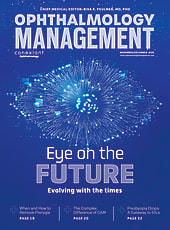
In this interview, Marjan Farid, MD, shares her insights on why patients discontinue treatments or cycle through different existing ones, what low compliance means for long-term patient outcomes, and what the physician and staff can do to address this.
Ophthalmic Professional: Why do patients discontinue treatments or cycle through different existing ones?
Marjan Farid, MD: Over the course of my career as an ophthalmologist, I have experienced firsthand the challenges that come with diagnosing and treating dry eye disease (DED). I have also witnessed my patients’ ongoing struggle to manage chronic symptoms that extend beyond physical discomfort, affecting their emotional and mental wellbeing.1-5
Patients often discontinue treatment as many commonly used DED treatments have limitations, leading to patient dissatisfaction and poor adherence.6-10 Many patients are left feeling hopeless in their search for effective symptom management. In fact, 9 out of 10 patients discontinue their initial medication within a year.10* The subsequent cycling through different treatments in the hope of effective, lasting relief can amplify frustrations for both physicians and patients.8-10
OP: What does low compliance mean for long-term patient outcomes?
MF: Low compliance can have serious consequences. If untreated, DED can often become chronic and progressive. While some patients may not initially present these concerns, their symptoms and emotional challenges may grow over time.1-5 Tear deficiency leads to ocular surface inflammation, nerve damage, and reduced stimulation of the lacrimal functional unit.11-12 Beyond the physical discomfort of DED and its impact on overall eye health, patients also face significant psychological and lifestyle challenges, including negative impacts to work productivity, social activities, reading, driving at night, use of digital devices, and inability to wear contact lenses or undergo cataract or refractive surgery. Symptoms that accompany a decrease in natural tear production can be exacerbated by the things that patients face in everyday life—the use of digital devices, aging, and air pollution.13-14
Beyond physical symptoms, there are emotional implications. When patients don’t feel supported in their treatment journey, they may become less motivated to stay on therapy or return for follow-up care.
OP: What can the physician and staff do to address this?
MF: A comprehensive/personalized approach is essential for improving both compliance/treatment satisfaction in DED. As physicians, it’s important to move beyond symptom checklists and engage in meaningful conversations—asking questions like, “When are your symptoms most disruptive?” or “How does this affect your daily life?” Tailoring treatment plans to what matters most to the patient builds stronger therapeutic partnerships.
With several FDA-approved therapies now available—including acoltremon ophthalmic solution 0.003% (Tryptyr; Alcon), a recently FDA approved eye drop, along with existing options like cyclosporine ophthalmic emulsion 0.05% (Restasis; AbbVie), lifitegrast ophthalmic solution 5% (Xiidra; Bausch + Lomb), perfluorohexyloctane (Miebo; Bausch + Lomb), semifluorinated alkane (Vevye; Harrow), and arenicline solution 0.03% (Tyrvaya; Viatris)—we’re better equipped than ever to individualize care. But treatment success still depends heavily on communication and consistency.
Staff can reinforce education, guide proper use of treatments, and provide ongoing support. Building trust starts with validating the patient’s experience and helping them understand that managing DED often requires consistent, long-term care. Regular check-ins, even brief ones, help us adjust plans as needed and show patients that we’re committed to their progress.
OP: Is there anything else that you would like to discuss?
MF: DED affects millions of people worldwide, but less than 10% of diagnosed patients are being treated with a prescription product.15 Among patients with DED, only 13% feel their condition is well-managed.16** This persistent disconnect underscores the urgency for not only new therapies, but also a more holistic, empathetic approach to care.
Recent FDA approvals—including Tryptyr, as well as existing therapies like Restasis, Xiidra, and Tyrvaya—reflect ongoing progress in addressing the signs and symptoms of DED.
Ultimately, managing DED means treating both the physical and emotional burden of the disease. By taking time to listen, educate, and individualize care, we can help patients feel more supported, more hopeful—and better equipped to manage their condition. OP
**Based on an online survey conducted by Chronic Dry Eye from February to April 2021 among 415 responders who reported being diagnosed with chronic dry eye. Of these, 44% reported a severe level of chronic dry eye (ie, levels 3 and 4).
References
1. Galor A, Britten-Jones AC, Feng Y, et al. TFOS lifestyle: impact of lifestyle challenges on the ocular surface. Ocul Surf. 2023;28:262-303. doi: 10.1016/j.jtos.2023.04.008
2. Basilious A, Xu CY, Malvankar-Mehta MS. Dry eye disease and psychiatric disorders: a systematic review and meta-analysis. Eur J Ophthalmol. 2022;32(4):1872-1889. doi: 10.1177/11206721211060963
3. Craig JP, Nichols KK, Akpek EK, et al. TFOS DEWS II Definition and Classification Report. Ocul Surf. 2017;15(3):276-283. doi:10.1016/j/jtos/2017.05.008
4. Uchino M, Schaumberg DA. Dry eye disease: impact on quality of life and vision. Curr Ophthalmol Rep. 2013;1(2):51-57. doi: 10.1007/s40135-013-0009-1
5. Chan C, Ziai S, Myageri V, Burns JG, Prokopich CL. Economic burden and loss of quality of life from dry eye disease in Canada. BMJ Open Ophthalmol. 2021;6(1):e000709. doi: 10.1136/bmjophth-2021-000709
6. Wilson SE, Perry HD. Long-term resolution of chronic dry eye symptoms and signs after topical cyclosporine treatment. Ophthalmology. 2007;114(1):76-79. doi: 10.1016/j.ophtha.2006.05.077
7. Semba CP, Gadek TR. Development of lifitegrast: a novel T-cell inhibitor for the treatment of dry eye disease. Clin Ophthalmol. 2016;10:1083-1094. doi: 10.2147/OPTH.S110557
8. Hovanesian JA, Nichols KK, Jackson M, et al. Real-world experience with lifitegrast ophthalmic solution (Xiidra) in the US and Canada: retrospective study of patient characteristics, treatment patterns, and clinical effectiveness in 600 patients with dry eye disease. Clin Ophthalmol. 2021;15:1041-1054. doi: 10.2147/OPTH.S296510
9. Cook N, Mullins A, Gautam R, et al. Evaluating patient experiences in dry eye disease through social media listening research. Ophthalmol Ther. 2019;8(3):407-420. doi:0.1007/s40123-019-018
10. Mbagwu M, LaPrise A, Harris J, Nair AA, Fain J, Harrison DJ. Characterization of discontinuation and switching patterns of dry eye disease medications using linked EHR registry and claims data. Presented at: the American Society for Cataract and Refractive Surgery Conference; April 5-8, 2024; Boston.
11. Sacks RA, Beaton A, Sathe S, Morris C, Willcox M, Bogart B. Towards a closed eye model of the pre-ocular tear layer. Prog Retin Eye Res. 2000;19(6):649-668. doi:10.1016/s1350-9462(00)00006-9
12. Dieckmann G, Fregni F, Hamrah P. Neurostimulation in dry eye disease—past, present, and future. Ocul Surf. 2019;17:20-27. Doi.org/10.1016/j.jtos.2018.11.002
13. Mathers WD, Lane JA, Zimmerman MB. Tear film changes associated with normal aging. Cornea. 1996;15(3):229-234. doi: 10.1097/00003226-199605000-00001
14. Jones L, Downie LE, Korb D, et al. TFOS DEWS II Management and Therapy Report. Ocul Surf. 2017;15(3):575-628. doi: 10.1016/j.jtos.2017.05.006
15. 2023 Dry Eye Products Markets Report, Market Scope, 2023
16. Morse H, Henneberger S, Reed J, et al. 2021 in American survey findings: living with chronic dry eye. ChronicDryEye. August 10, 2021. Accessed September 23, 2024. https://chronicdryeye.net/infographic/in-america-findings.









